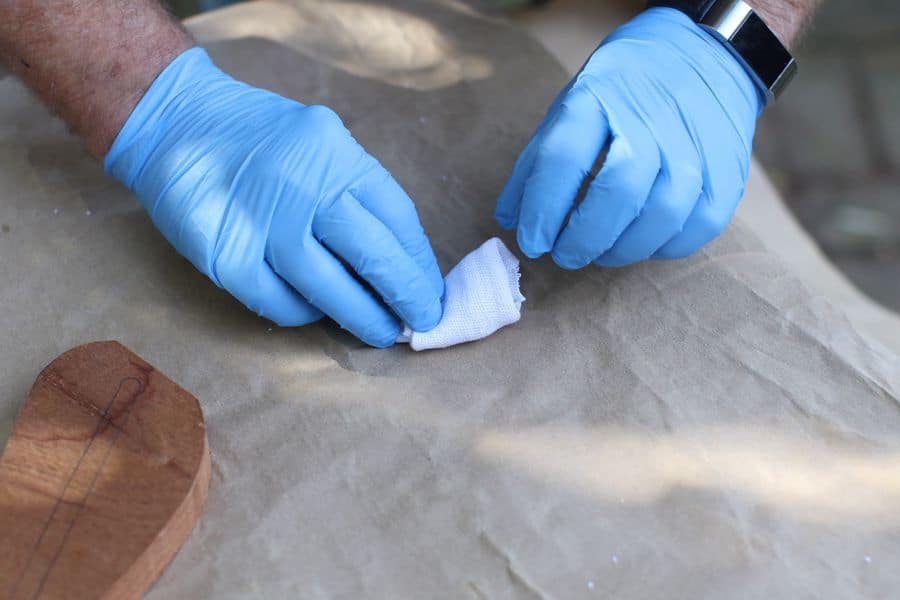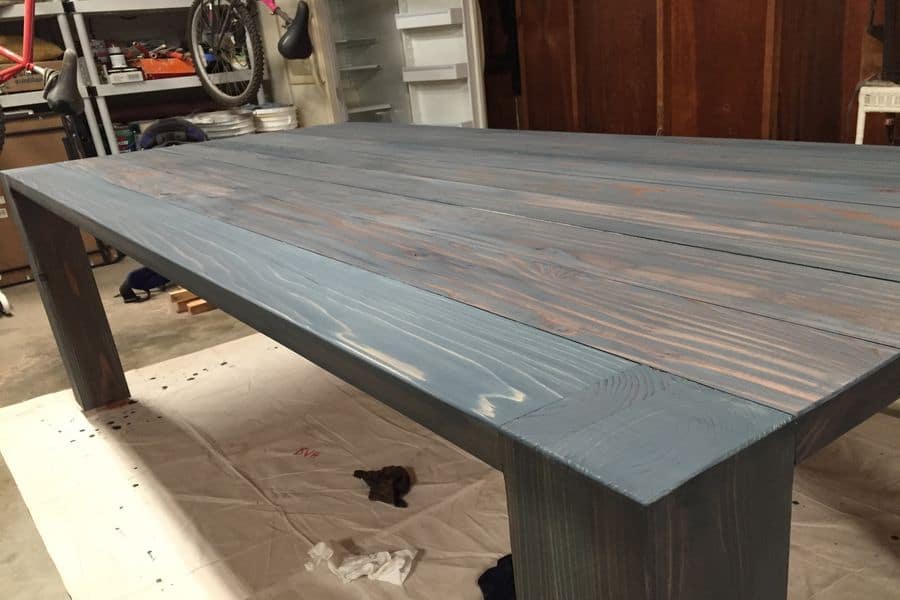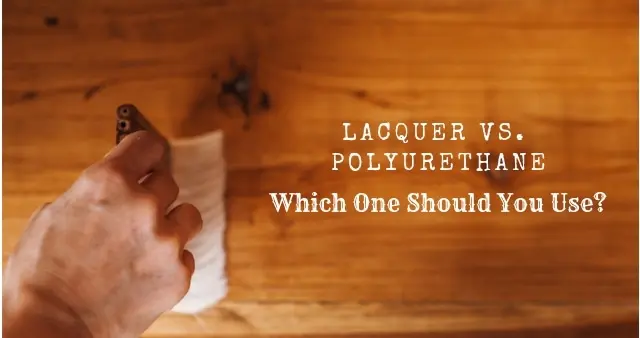When stain is too dark, it can detract from the beauty of the wood. Read on to learn several methods for removing dark stain from wood. This article covers the removal of commercial stain with oxalic acid, two-part wood bleach, and laundry bleach.
It also addresses a removal technique for black water stains on wood.
Contents
Removing Dark Stain From Wood
If you have a piece of furniture, wood paneling, or even a hardwood floor that just feels too dark, you can easily brighten it up using one of the methods detailed below. They will work well on either water-based or oil-based stains.
Use Oxalic Acid
Oxalic acid will remove even dark commercial stain from wood, whether they are oil-based or stain-based. It is the first choice for dark stain removal because it will not affect the underlying color of the wood. It works for removing stain in the toughest of environments such as decks.

- Know the dangers. Oxalic acid is toxic to humans in doses as low as five to 15 grams. Less than a tablespoon of this acidic and chelating chemical can cause shock, convulsions, and even cardiac collapse. If you have pets or small children, it may be best to choose another dark stain removal method. Store oxalic acid in a childproof location, and make sure it is clearly labeled.
- Buy oxalic acid dihydrate. Oxalic acid comes in either vapor or solid form. The solid version is known as oxalic acid dihydrate, and is composed of tiny crystals. It is odorless and easily dissolvable in water. The vapor form of oxalic acid is used to protect beehives from certain types of mites, while the liquid created when crystals and water combine is commonly referred to as ‘wood bleach’. It can usually be purchased at drugstores and home improvement centers.
- Control the area. Oxalic acid will bleach anything it comes in contact with, so it is important to protect any wood you don’t want bleached. Use painter’s or masking tape and plastic sheeting to cover up any part of the workpiece or surface that doesn’t need dark stain removed.
- Protect yourself. Apart from being toxic when ingested, oxalic acid is irritating to the skin and in rare cases may cause chemical burns. It will also bleach clothing. Inhalation is similarly dangerous, causing severe irritation of the nose and throat as well as possible kidney injuries. To work with oxalic acid, use disposable coveralls, goggles, a face shield, impenetrable gloves, and a respirator-type mask. Spilled crystals may even stick to the tread of your shoes, so consider adding shoe covers as well.
- Prepare the wood. Strip any clear coat, varnish, or lacquer from the surface of the wood using an appropriate stripper. Sand the surface of the wood, opening the grain and making it more capable of absorbing the wood bleach mixture. Avoid adding scratches to the surface of the wood by sanding only in the direction of the grain.
- Mix the crystals with water. For small stain removal jobs, add one to two ounces of oxalic acid to a pint of water. For medium-sized projects, use a quart of water and three or four ounces of oxalic acid. To make an entire gallon of wood bleach, you will need 12 to 16 ounces of oxalic acid.
- Apply the mixture. Use a brush, rag, or mop to coat the surface of the wood. Let it dry completely. If colorants still remain, reapply the oxalic acid wood bleaching mixture. Be sure to wait for the wood to dry completely before recoating.
- Neutralize the acid. When you’re satisfied with the level of dark stain removal, mix two tablespoons of borax with a quart of water, and use it to coat the surface of the wood. Wait for the borax to dry, and then rinse the wood with water and let that dry. Continue rinsing the wood and letting it dry until no powdery residue remains.

Use Two-Part Wood Bleach
Unlike oxalic acid, which removes stain added to wood without changing the color of the underlying workpiece or floor, wood bleach lightens the wood itself. It will also de-color both pigments and dyes.
- Know your parts. Two-part wood bleach comes in two bottles. One bottle contains sodium hydroxide, also known as lye. Lye is caustic to the esophagus and stomach if swallowed in significant amounts – make sure to keep it in childproof location to avoid accidental poisoning. The other bottle contains hydrogen peroxide. They are usually labeled ‘A’ and ‘B’
- Read the instructions. Each manufacturer has a recommended method for how to apply their product. You may be advised to mix both parts together. Sometimes one part is applied to the wood first, and allowed to dry. Then, the other part is added to the dry wood. Other products may advise you to apply one part, wait for a predetermined interval, and apply the second part while the wood is still wet.
- Protect your eyes and skin. Neoprene gloves are recommended to avoid skin contact with caustic bleach. Cuff the edges, to prevent bleach from dripping down the gloves and onto your arms. For your eyes, wear goggles or a face shield. A waterproof apron or coveralls will help protect you from any splashes.
- Brush carefully. Use a synthetic bristle brush to apply the parts, following the manufacturer’s instructions with regard to
- Don’t panic. Lye temporarily darkens wood before the bleaching action occurs. This can be panic-inducing the first time you see it, just be patient and give the substance time to work. Hydrogen peroxide will bubble and foam as it comes into contact with the stain, this is perfectly normal.
- Dry overnight. By the time you wake up in the morning, the two-part wood bleaching solution will have worked it’s magic. For dark stain, you will likely need to repeat the process several times in order to get down to bare wood. If stubborn patches remain after several coats of two part bleach, you will need to use abrasive methods to remove the rest of the stain. Rinse the bleach away and allow the wood to dry. Use sanding paper or steel wool to scrub of colorant. Work in the direction of the grain to avoid scratches.
Use Household/Laundry Bleach
The kind of bleach you use for your laundry is weaker than either oxalic acid or a two-step wood bleach. It will still work to remove stain, but may take several applications, especially when dealing with a dark-hued stain.

Follow the application and neutralizing instructions above, substituting laundry bleach for a two-part bleaching solution. This method is best when you just have a small stain to remove and don’t want to purchase a special product.
Can You Remove Black Stains From Wood?
Black stains can be removed from wood with hydrogen peroxide.
The cause of black streaks on wood is usually moisture damage, which occurs when something wet breaks through a damaged or incomplete clear coat. Common causes of moisture include; rings from drink glasses set down on tables, wet boots on hardwood floors, or even pet urine.
While the steps listed above will also work to remove these water-based stains, they can generally be removed using a substance you probably already have under the sink. Brushing hydrogen peroxide onto the black streaks, then covering them overnight with a rag soaked in hydrogen peroxide is usually sufficient to banish the stains. If not, move on to the laundry bleach method.
Your next steps will be to sand the entire surface and reapply a clear top coat. If the surface was colored with commercial wood stain, you will also need to re-stain the affected area to maintain consistent color.
Conclusion
A bleaching agent is used to remove stains and colorants from wood. Bleaching agents include oxalic acid, two-part bleach solution, laundry bleach, and hydrogen peroxide. The first three bleaching agents listed are appropriate for removing commercial stains.
The last method is gentler, and can be used to remove water stains from wood.
